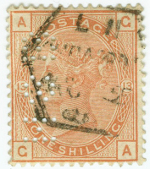
Discussion - Member to Member Sales - Research Center

Discussion - Member to Member Sales - Research Center

Wondering if this was due to any particular reason I did some Googling but other than the fact the numbers printed were quite low, due primarily to the Post Office ramping up AFM's (automatic facing machines) in the sorting offices could find no other reason.
However, on my searches I came across this website with terrific pictures of presses, though today H&S would have field day.
http://deltastamps.com/Fact14LSD1960.htm
Makes interesting viewing.

Login to Like
this post
Reading the article closely, I am of the opinion that the phosphor stamps were only issued at first to the areas where the appropriate machinery was installed. As initially this was experimental, and then I suppose phased in over time, the percentage of stamps with the phosphor applied would be very small - hence their relative scarcity. Of the many stamps which have passed through my hands those with the 2 early phosphors are quite scarce while those with the latest one (carried forward into the Machin period) are much more common.By the time that the Machins were introduced the machinery would be in use universally ( or at least planned to be ) and so all stamps were issued phosphorised.
Malcolm

Login to Like
this post
While I admire those who collect these phosphor stamps, stamps identical to their non-phosphor dopplegangers-- except for invisible phosphor bands, I cannot collect them. I removed those pages from my Great Britain album. I may be perceived as a barbarian for doing so, but the idea of needing a special phosphor detecting light to determine between two seemingly identical stamps seems extraordinary.
I love watermarks and perforations. They are in the natural scheme of things -- requiring only fluids and mechanical guides to unravel the mystery, and you can see them with the naked eye in many cases. Phosphor stamps, on the other hand, are the devil's handiwork. More annoying than Daylight Savings Time.
Then again, I didn't throw away the pages.
Eric

Login to Like
this post

Following a members request for 1960's GB stamps used with Phosphor bands,searching through my duplicates revealed only a couple.
Wondering if this was due to any particular reason I did some Googling but other than the fact the numbers printed were quite low, due primarily to the Post Office ramping up AFM's (automatic facing machines) in the sorting offices could find no other reason.
However, on my searches I came across this website with terrific pictures of presses, though today H&S would have field day.
http://deltastamps.com/Fact14LSD1960.htm
Makes interesting viewing.

Login to Like
this post
01:57:22pm
re: Printing presses for GB stamps.
Reading the article closely, I am of the opinion that the phosphor stamps were only issued at first to the areas where the appropriate machinery was installed. As initially this was experimental, and then I suppose phased in over time, the percentage of stamps with the phosphor applied would be very small - hence their relative scarcity. Of the many stamps which have passed through my hands those with the 2 early phosphors are quite scarce while those with the latest one (carried forward into the Machin period) are much more common.By the time that the Machins were introduced the machinery would be in use universally ( or at least planned to be ) and so all stamps were issued phosphorised.
Malcolm

Login to Like
this post

re: Printing presses for GB stamps.
While I admire those who collect these phosphor stamps, stamps identical to their non-phosphor dopplegangers-- except for invisible phosphor bands, I cannot collect them. I removed those pages from my Great Britain album. I may be perceived as a barbarian for doing so, but the idea of needing a special phosphor detecting light to determine between two seemingly identical stamps seems extraordinary.
I love watermarks and perforations. They are in the natural scheme of things -- requiring only fluids and mechanical guides to unravel the mystery, and you can see them with the naked eye in many cases. Phosphor stamps, on the other hand, are the devil's handiwork. More annoying than Daylight Savings Time.
Then again, I didn't throw away the pages.
Eric

Login to Like
this post

